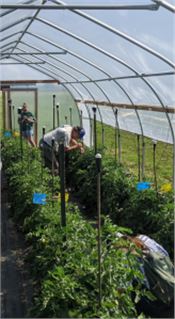Using Sticky Cards In High Tunnels
LEXINGTON, KENTUCKY
High tunnels are wonderful tools for extending the growing seasons but they can also be houses for multiple types of insect and mite pests.
Monitoring for these pests is highly recommended in order to intercept their populations before they are able to build to damaging levels.
When monitoring, you can get up close and personal with the plants looking for the pests themselves or for the symptoms they leave behind. Many of the pests in high tunnels are “sucking pests,” meaning that they siphon fluids from plants for food. This creates diagnostic symptoms including curled leaves (aphids), silver flecks (thrips), and stippling (mites). However, you can’t be in the high tunnel all the time, so it is good to invest in some sentinel tools that can be watching for you 24/7. In this case I’m not talking about security cameras, I’m talking about sticky cards.
What’s a sticky card?
“Sticky card” is the common name associated with “sticky insect traps” sold for use near plants. They look vaguely like index cards and are extremely sticky, hence the name. These glue-coated board traps can come in different dimensions, although 5 X 7 is one of the more common sizes. They are usually rectangular, although square and even butterfly shaped ones are out there. They can be blank or come with grids printed on them. They are sold by numerous retailers for varying amounts; just remember you always get what you pay for.
Sticky cards can be blue or yellow. Yellow is the most common color sold and the one that catches the most pests; you can find aphids, thrips, whiteflies, mites, leafhoppers, and more on them. Blue cards are also useful although they are most commonly deployed for thrips monitoring. It’s great if you can buy both colors and pair them in the high tunnel, but if you can only afford one color, go with yellow.
What are they for?
One misconception I see in many online forums is that these sticky cards help to manage pest populations. That is not really the case; they won’t catch enough bugs to reduce their numbers. They are there for monitoring. Inherent in that term though is that they must be looked at. Sticky cards that don’t get checked might as well not be there. I would encourage you to plan on putting up new cards every other week and using a hand lens or magnifying glass to look at what you have snared on the old ones. If you take detailed notes or even produce a map of what pests you see on which cards from which location, you might be able to build a hot spot map and better be able to deploy your management solutions.
How should I use them?
You should install sticky cards in multiple locations in the tunnel.
Some key spots would be near entry and exit points for the tunnel, in the center of the tunnel, and the ends of rows. You can use as few as two traps per tunnel but having a few more helps to better understand where pests are most commonly entering the tunnel, 6 to 10 per tunnel is usually sufficient.
You can stretch your sticky card budget by cutting them roughly in half before placing them in the tunnel. When they are used in UK high tunnels, researchers do just that, and the blue and yellow cards are paired. The cards should be placed at about plant height. To accomplish this, we (UK researchers) usually have a stake that will be used to support the cards. We then glue two clothespins together, one flat end to the other; this creates a movable clip. One of the clothespins grips the stake, the other holds the card. Some companies that sell sticky cards may provide a wire that can do something similar.
When you collect the cards, you can wrap a sheet of clear plastic food wrap around each one to provide a barrier between you and the glue, while still allowing you to see and examine the trapped pests. Then you can use a magnifier to look at what you have caught and make decisions on how to best act next.
While the cards won’t give you an absolute count of pests in the tunnel, they can give you a good estimate of pest pressure and allow you to catch populations before they start to grow exponentially. It can be tough to know what you are looking at. Once they get coated in glue, pests can start to look a little different than usual. Here are some examples that might help you with identification in the future.
After you deduce which pests you have, you can choose a biological control option to limit their population or implement an insecticide application to manage them. ∆
DR. JONATHAN L. LARSON: Entomology Extension Specialist, University of Kentucky

Figure 3: On the left is a fungus gnat, which can usually be found at their highest numbers on cards in the spring and fall. On the right is an immature aphid next to a thrips. Without magnification it can be hard to tell the difference between blobs in glue. Be sure to invest in a good hand lens.

In this high tunnel run by Dr. Rachel Rudolph (UK Horticulture), you can see pairs of blue and yellow sticky cards hung on rebar posts. They are positioned throughout the tunnel to help her know where pests may be invading from.
Photos by Jonathan L. Larson, UK

On the left is a representative thrips on a yellow sticky card. They are often light in color but have fringed wings and obvious, tiny eyes. On the right is a winged aphid. Many aphids caught on cards are dark in color and have wings.